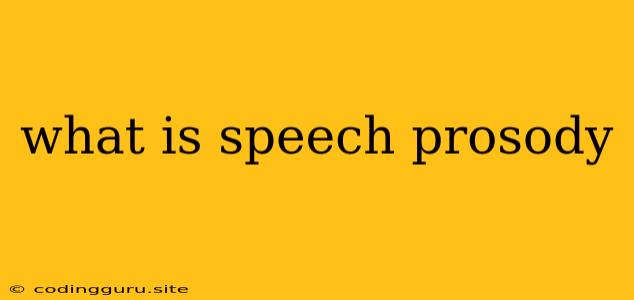What is Speech Prosody and Why Does It Matter?
Have you ever wondered what makes someone's voice sound happy, sad, angry, or excited? It's not just the words they use, but also how they say them. This is where speech prosody comes in.
Speech prosody, also known as prosodic features, refers to the rhythm, stress, and intonation patterns of speech. It's the melody of language, the invisible music that adds meaning and emotion to our spoken words. Think of it like the punctuation marks of spoken language, guiding the listener to understand the nuances of what is being said.
What are the Key Elements of Speech Prosody?
Speech prosody is comprised of three main components:
-
Intonation: This refers to the rise and fall of pitch in speech. It's what allows us to distinguish between a statement and a question, or to convey excitement, doubt, or surprise. For example, a rising intonation at the end of a sentence often indicates a question, while a falling intonation usually signifies a statement.
-
Stress: Stress refers to the emphasis placed on certain syllables within a word or words within a sentence. This emphasis helps to highlight important information and distinguish between different meanings. For instance, the word "present" can be stressed on the first syllable to mean a gift, or on the second syllable to mean "being in a specific place."
-
Rhythm: Rhythm refers to the timing and pacing of speech. It can be influenced by factors like the speed of delivery, the pauses between words, and the length of syllables. Think of how a poem or a song has a distinct rhythm. Similarly, speech can have different rhythms based on the context and the speaker's intentions.
Why is Speech Prosody Important?
Speech prosody plays a crucial role in our communication and understanding of language. It allows us to:
-
Convey emotions: We use speech prosody to express a wide range of emotions, from joy and excitement to sadness and anger. Imagine saying "I love you" in a monotone voice versus saying it with a warm and loving intonation. The impact is drastically different.
-
Highlight information: Prosodic features can help us emphasize key information and make it easier for listeners to understand the main points of a conversation. For example, raising our pitch on a specific word can make it stand out.
-
Differentiate meaning: Speech prosody can change the meaning of a sentence, even if the words themselves remain the same. Think of the difference between saying "You're going to the store?" with a rising intonation (a question) and "You're going to the store!" with a falling intonation (a statement).
-
Enhance engagement: Speech prosody can make our speech more engaging and captivating for listeners. A speaker with good speech prosody can keep their audience interested and attentive.
The Role of Speech Prosody in Language Acquisition
Speech prosody is crucial for language acquisition, especially in infants. Babies learn to recognize different emotions and meanings based on the prosodic features of their caregivers' speech. As they develop, they begin to imitate these patterns, eventually becoming proficient in using speech prosody themselves.
Challenges with Speech Prosody
While speech prosody is a fundamental aspect of communication, it can also pose challenges for:
-
Non-native speakers: Learning a new language often involves mastering its unique prosodic features, which can be difficult for learners.
-
Individuals with speech disorders: Some individuals with speech disorders may struggle with producing or interpreting speech prosody, affecting their communication abilities.
-
Technology: Speech recognition software and AI are still under development when it comes to understanding and processing speech prosody, leading to occasional misinterpretations.
Improving Your Speech Prosody
If you're interested in enhancing your speech prosody, consider these tips:
-
Pay attention to your voice: Become aware of how your pitch, stress, and rhythm vary when you speak.
-
Practice reading aloud: Reading aloud with expression can help you develop your prosodic skills.
-
Listen to native speakers: Pay attention to how native speakers use speech prosody to convey different meanings and emotions.
-
Record yourself: Listening to recordings of your own speech can help you identify areas where you can improve.
Conclusion
Speech prosody is an essential part of human communication, adding richness and nuance to our spoken language. Understanding how it works can help us become better communicators and enhance our ability to connect with others. From conveying emotions to highlighting important information, speech prosody plays a crucial role in how we understand and interpret the world around us.
